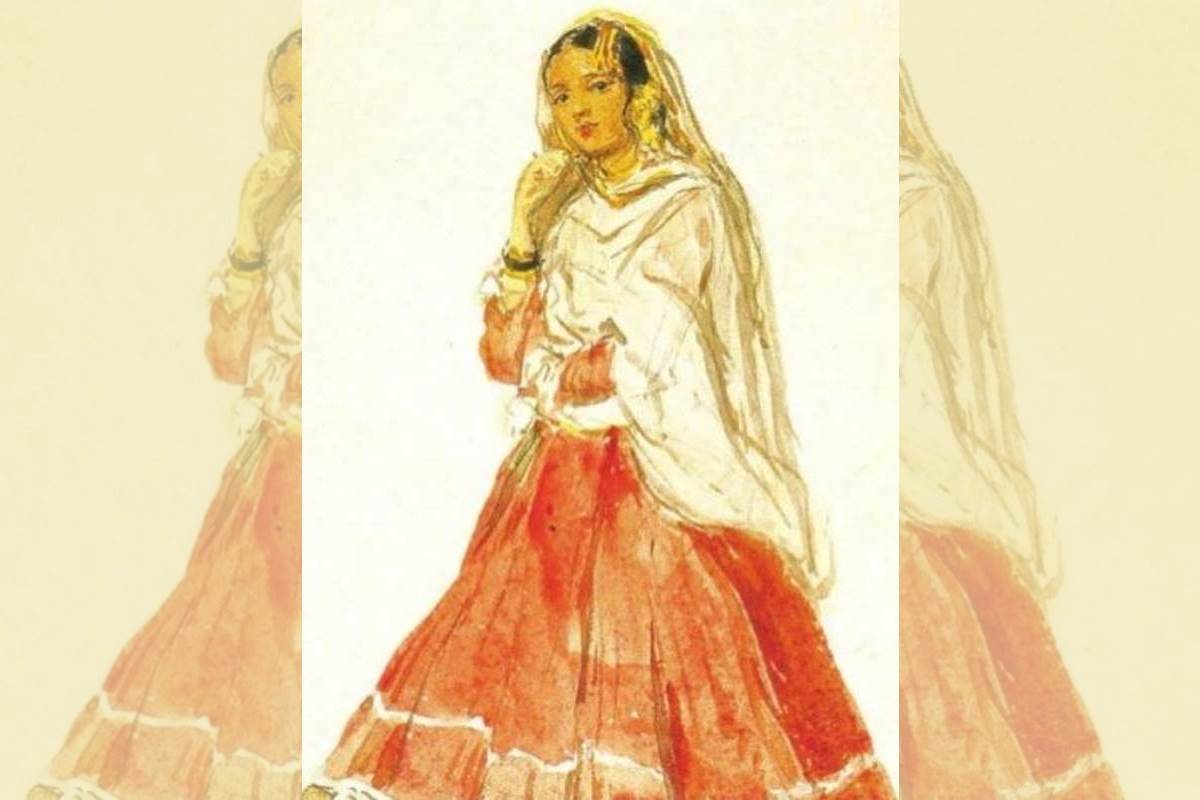The dancing girls of erstwhile Rajputana (who came to be known as the houris of paradise on earth) made frequent forays into neighbouring cities, including Delhi and Agra. Some of these dancing houris also came from Kashmir and Sindh, the most famous of them being Sir Richard Burton’s favourite Mahtab (Moonbeam of Larkhana). Also hogging the limelight were the nautch girls of Alwar, Udaipur and the Rajputani bride of noted photographer William Daniell, besides Amber Kooer, Rajput bibi of Sir Charles Malet.
Pran Nevile, doyen of Raj era writers, who died last December aged 95, has left his legacy to his entrepreneur son Rahul Nevile, once a leading exporter of shoes to East Europe. His father has written extensively in his book, Nautch Girls of India on such courtesans as Alfina, Nicki and Khaunm, who made their presence felt right up to British times, along with the Armenian singer Gohar Jan, attached to the court of the Dholpur ruler. An interesting feature of his remarkable research is the emergence of dancing girls and Hijras as potential voters sought by most parties. This seems to hold good even during the present Lok Sabha and State Assembly election campaigns.
Two categories of citizens excited curiosity, and in some cases derisive laughter by the churlish, during the earlier elections. Dancing girls and eunuchs also exercise their franchise in case they are lucky enough to find their names in the voters’ list. In many cases it was difficult to distinguish dancing girls from other sari or salwar-kameezclad women. But many of them could be recognised by their makeup and mannerism. As for the third sex, they made their presence all too obvious.
Chhoti and the others of her clan clapped to mark their arrival and in one place in Uttar Pradesh they demanded a separate queue as they never wanted to stand with the men because the latter objected. And when they stood with the women, some of the fair sex took objection too. However, this was an isolated incident, for common queues are now formed at most polling centres. Some of the dancing girls were conspicuous because of their coquetry ~ the flexible waist and sway of the hips, the movement of the eyes and itching eyebrows, hands akimbo and so many other traits, which come with long practice of their profession.
One is reminded of a news item in the popular Hindi daily Amar Ujala some decades ago when a group of eunuchs created a scene at a polling booth. Not to be outdone, some dancing girls too came up with strange requests. A few of them wanted the indelible ink mark to be put on their cheeks. And as if to spite them a newly-married woman suggested to the polling officer that the mark be put just above her nosegay.
No such reports were received during the 2014 elections though at some places, one dare say, strange incidents must surely have occurred, considering the mammoth electorate spread throughout the length and breadth of the country. In the rural areas, women came in groups, their ghoonghatsdown, singing the dilties, which still enthuse village folk. A man playing the Tabla or Dholak and a boy beating time with cymbals lent orchestral support to the vocal groups. All this reminds one of the days when women went singing to the many fairs held in the Walled City of Jaipur and outside it. Those were also the times when eunuchs and dancing girls had their quarters in Delhi’s Chawri Bazar. It was later that they moved to GB Road, though the eunuchs had started living at the Turkman Gate much earlier. Chawri Bazar, which forms the backyard of the Jama Masjid in Delhi, is now a congested street.
But Chawri Bazar was not always so. It was the promenade of Shahjahanabad, where the rich and the young came to enjoy the evening till the time of the Partition. There were many big buildings here where the courtesans had their “kothas”. Nur Bai, the famous dancing girl of Mohammad Shah, dwelt here in the 18th century. She was the one who told the invader Nadir Shah about the Kohinoor hidden in the turban of the emperor.
There were many other famous courtesans, like Chamani, Bahenia, Firdaus, Nilofar, Mumtaz Jan and Nassiman Jan, who were not merely women of easy virtue but repositories of art, culture and manners, observed Pran Nevile in his book on dancing girls. Firdaus Jan was so beautiful that noblemen had to make a prior appointment for meeting her. Many a Nawab, who courted Chamani Ram Jani’s charm, became a pauper and as for Behema, even the harem ladies envied her because she was the concubine of Etmad-ud-Daulah and people salaamedher whenever she passed by in her horse-drawn carriage.
Poets also had mistresses, Ghalib’s heartthrob was a dark-skinned dancing girl, who inspired him to write some of the best verse of his life. She was a big contrast to his devoted wife Umrao Begum, a religious-minded woman but then the lure of the tavern is greater for those who cannot make it to the mosque. And Ghalib was no exception. The street of beauties paid for its sins twice ~ once during the Mutiny and the second time in 1947.
It was not as bad as Sodom and Gomorrah but still comparisons are easy to draw. The “mujra” is no longer the same and Nur Bai and Firdaus are long forgotten names in bazaar gossip. Now it is in GB Road, where the passions of society are supposed to find an outlet. And yet in this so-called Red Light area a pathetic drama of the vanity of human emotions is enacted every day by the exploiters and the exploited. How many of those who expose themselves on the balconies, wearing garlands thrown at them, are women of ill-repute is hard to say.
There are those who were born into it, those who were forced into the world’s oldest profession (after agriculture of course). One feels sorry for them. Still, this unfortunate segment of society cannot be wished away. It is there and is echoed in the trite ghazals one hears on the futility of love and faithless beloved. How poignant these words are to the situation in the area is evident, for love is not sold in the marketplace and those who profess to do so are deceiving not only others but themselves too.
Dancing girls are prisoners in a vicious circle of pimps, toughs and crime. And yet those who run the racket have their own code of conduct, something akin to honour among thieves. It’s an inbreeding society, marriages et al, and beggars too being exclusive to it, for they will take alms only from the hands of a dancing girl and none else. Some of the beggars belong to the faqir caste and others, mostly women are those who have been driven out of the profession because of age or disease and hence must beg at the very “Kothas” where they were once admired and pampered.
A strange twist of fate, notwithstanding the great names that adorn the history of the courtesans like Ahmed Ali’s creation Huma or the celebrated Umrao Jaan Ada, or the pre-Partition craze Chameli Jaan. However, courtesans such as these have long ceased to exist. Now there are only “Bais” sans sophistication. But passing by some evening one cannot close one’s ears to the ankle bells jingling to the beat of the tabla and paan-fed voice intoning through the very nosegay that pensive air, “Tujhe rukh-eroshan se parda uthana hoga (you will have to lift the veil).” That indeed is the tragedy of those who wear the veil and those who rend it.
Pran Nevile, says Rahul, was not averse to venturing into the kothas of pre-Partition Lahore, Delhi, Agra and Jaipur to authenticate his research. He was the one who discovered the Sindh-Jaipur link of the courtesans like Amanath Jan, Surkhab, Zenaab Lachakti Qamar, Jameela Jan, Sitara and many others, hailed as “Peris or fairies”, they entertained not only the Thakur gharanas at weddings but also the Maharajas among whom Sawai Madho Singh II was the most prominent as he was a lover of dance and song and cocktail parties. The Sindh tawwaifs then found a bigger market to sell their charms in Delhi, where besides the rajas and maharajas of princely States, the nawabs and nawabzadasof the Capital and neighbouring areas were among the honoured clientele.
According to Pran Nevile the British, while planning New Delhi, decided to have the Red Light area in GB Road so that it was more accessible to lovers of the Mujra, who found Chawri Bazar too congested. No wonder among the clients of the Randis were quite a number of Sahibs, who did not mind showering their beauty on Nautch Girls even in Jaipur, besides Delhi. Henry Sahib, Cyril Sahib and Martin Sahib are still remembered by Jaipurwallahs in the list of “Randibaz” of colonial days. One of them, probably Solomon Sahib, even died at a Kotha during a Mujra. Though Pran Nevile is no more one still gets a thrill while reading his stories.










